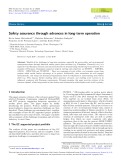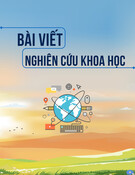
REVIEW ARTICLE
Safety assurance through advances in long-term operation
Kevin James Mottershead
1,*
, Christian Robertson
2
, Sebastian Lindqvist
3
,
Francisco Javier Perosanz Lopez
4
, and Eija Karita Puska
3
1
Materials Science & Structural Integrity, Wood, Warrington, UK
2
DEN-DMN, CEA, Saclay, France
3
VTT, Espoo, Finland
4
Structural Materials Division, Technology Department, Ciemat, Madrid, Spain
Received: 5 April 2019 / Accepted: 4 June 2019
Abstract. Mindful of the challenges to long-term operation, especially the severe safety and environmental
consequences shown through historical nuclear power plant accidents (e.g. Fukoshima, Chernobyl, etc), it is
imperative that European research and innovation focuses on demonstrating reliable long-term operation. Five
examples of European Commission supported projects meeting such objectives are INCEFA+, SOTERIA,
ATLAS+, MEACTOS and NUGENIA+. There are economies of scale within, and synergies across these
projects which enable further advantage to be gained. Additionally, since researchers are well engaged
internationally, this brings into European Organisations latest developments in understanding from further
afield (e.g. USA, Japan), further enabling safety assurance advances, and enabling work overseas to be
influenced consistent with European requirements. Through examples, this paper provides evidence of the
advances claimed, whilst being careful to also declare areas of interest for which further work is still a priority.
1 Introduction
This paper presents evidence of the advances gained from
selected European Commission supported Horizon2020
and FP7 projects, supporting long-term operation of
nuclear power plant. The paper begins by briefly
introducing the projects. Nuclear industry operational
issues leading to long-term operation challenges are then
described. These challenges are summarised next, together
with examples of how the EC supported project portfolio
has combined to meet some of these. The paper concludes
with a summary of the challenges remaining, and activities
underway to meet them.
2 The EC supported project portfolio
The authors of this paper are coordinators of five EC
supported projects, four current, and one complete. These
are described briefly here, and their relevance to long-term
operation challenges is summarised later.
–INCEFA+
1
(INcreasing safety in nuclear power plants
by Covering gaps in Environmental Fatigue Assessment)
began work in July 2015 (though the consortium had
been together on an in-kind basis since 2013). 16
organisations participate in this project, which is funded
at €2.5 M over 5 years from the EC, and in excess of
€3.6 M from national sponsors. This project’s focus is on
creation of new environmental fatigue data aimed at
improving understanding of fatigue sensitivity to three
common parameters of interest, namely, effects of surface
finish, hold time and mean stress. The objective is the
creation of assessment rules that are able to predict
fatigue lives which are more consistent with plant
experience than is the case for present ASME/USNRC
guidance. The project will reduce assessment conserva-
tism through the creation of more reliable consistent data
than has hitherto been available; this is through partners
working to an agreed test protocol, and using common
material specimens all made in the same facility. Detailed
material and specimen characterisation data are collect-
ed to help understand data outliers.
*e-mail: kevin.mottershead@woodplc.com
1
This project has received funding from the Euratom Research &
Training programme 2014–2018 under grant agreement
N°662320. The project website is https://incefaplus.unican.es
EPJ Nuclear Sci. Technol. 6, 44 (2020)
©K.J. Mottershead et al., published by EDP Sciences, 2020
https://doi.org/10.1051/epjn/2019015
Nuclear
Sciences
& Technologies
Available online at:
https://www.epj-n.org
This is an Open Access article distributed under the terms of the Creative Commons Attribution License (http://creativecommons.org/licenses/by/4.0),
which permits unrestricted use, distribution, and reproduction in any medium, provided the original work is properly cited.





















